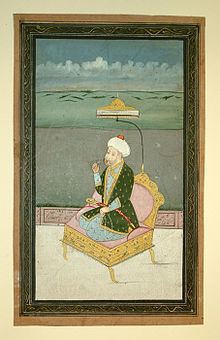Died 1469, Iraq | Parents Muhammad Mirza | |
 | ||
Born 1424Herat ( 1424 ) Spouse Khanzade BegumRabia Sultan BegumShah Sultan BegumSultanum BegumAka BegumRuqaiya Sultan BegumTarkhan BegumAfaq AghachaKhadija Sultan Aghacha Issue Sultan Ahmed MirzaSultan Muhammad MirzaSultan Mahmud MirzaUmar Shaikh Mirza IISultan Murad MizaSultan Walad MirzaUlugh Beg MirzaAba Bakr MirzaSultan Khalil MirzaShahrukh MirzaFakhr Jahan BegumBadi ul-Jamal BegumSultan Bakht BegumGowhar Shad BegumKhadija Sultan BegumShahar Banu BegumPayanda Sultan BegumZainab Sultan BegumAq Sultan BegumKhvand Sultan BegumKhanum Sultan Begum Children Umar Shaikh Mirza II, Sultan Ahmed Mirza Similar | ||
Mirza Abū Saʿīd Baig Mohammed Khan or Abū Saʿīd Mirza (Chagatay/Persian: ابو سعید میرزا) was the son of Muḥammad son of Miran Shah son of Amir Timur (Herat, 1424–1469), and was a Timurid Empire ruler in Transoxiana, Khurasan and the southern Caspian region, what is today parts of Turkmenistan, Kazakhstan, Uzbekistan, Iran, Azerbaijan and Afghanistan and member of the Timurid dynasty.
Contents
Background
Abū Saʿīd was the great-grandson of Timur, the grandson of Miran Shah, and the nephew of Ulugh Beg. He was the grandfather of Babur, by his son Umar Sheikh Mirza, the founder of the Mughal Empire in South Asia. As a young man his ancestry made him a principal in the century-long struggle for the remnants of Timur's empire waged between Timur's descendants, the Black Sheep Turkomans, and the White Sheep Turkomans (1405–1510).
Conquests
He raised an army but failed to gain a foothold in Samarkand or Bukhara (1448–1449); established his base at Yasi and conquered much of Turkestan in 1450. In June 1451, he captured Samarkand with the aid of the Uzbek Turks under Abūl-Khayr Khān, thus securing rulership of the eastern part of Timur's Empire, Transoxiana. He fought an inconclusive war with Mirza Abul-Qasim Babur bin Baysonqor of Khorasan in 1454; and took advantage of his cousin Jahan Shah's capture of Herat late in 1457 to capture it for himself in 1458, thus acquiring the rest of Timur's heartland and becoming the most powerful of the Timurid princes in central Asia. He defeated an alliance of three other Timurid princes at the Battle of Sarakhs in March 1459, and conquered eastern Iran and most of Afghanistan by 1461, agreeing with Jahan Shah to divide Iran between them; when the White Sheep Turkoman chieftain Uzun Hasan attacked and killed Jahan Shah, Abu Sa'id spurned Uzun Hasan's peace offer and answered Jahan Shah's son's request for aid.
Capture
Captured (on 11 February 1469 [NS]) by Uzun Hasan with a small force at the calamitous Battle of Qarabagh (in modern Republic of Azerbaijan) during a campaign against the Ak Koyunlu (White Sheep) Turkomans, he was handed over to Yadgar Muhammad Mirza on 17 February 1469, who executed him, ostensibly in retribution for Abū Sa'id's execution of Yadgar Muhammad Mirza's grandmother Queen Gawhar Shad, who had been intriguing against him.
Political Connections
Abu Sa'id formed many political connections during his rule, including to the Uzbeks, the Qara Qoyunlu Turkmen, and a variety of Sufi figures. He has been linked to Khwāja ʿUbaydullah Aḥrār (d. 895 AH/1490 CE) at the time of his accession (1451 CE) in Samarqand. He also sought support at the shrine of Ahmad Yasavi in Yasi.
Marriages
Abu Sa'id Mirza married nine times:
Legacy
Much has been made of Abū Saʿīd’s removal of tamgha taxes at the request of Khwāja Aḥrār, but these taxes were removed by earlier Timurids as well, and the action may have been as much a reversal of an earlier, little-liked ruler as a shift in policy toward Islamic taxation systems. Khwandamir reports that court officials were deposed and sometimes killed for misappropriating funds, including the same Quṭb al-Dīn Ṭaʾūs Simnanī who later is responsible for the construction of the Juy-i Sulṭānī. Women could also be caught up in the court intrigues. As mentioned in Aubin and discussed more fully by Manz, Abū Saʿīd’s execution of Gawhar Shād, the wife of Shāh Rukh b. Timur (779-850/1377-1447) was viewed negatively by the contemporary chroniclers.
Abū Saʿīd does not seem to have personally engaged in large-scale building projects, perhaps because of the time he spent on campaigns. Quṭb al-Dīn Ṭāʾūs, a vizier under Abū Saʿīd, built the Jūy-i Sulṭāni canal in Herat, which created the possibility for future building under Sulṭān Ḥusayn Bayqārā as it was completed while Abū Saʿīd was on his final campaign to Azerbaijan. This and the Aq Sarāy (white palace) shifted the elite living space while the ruler was in Herat to outside the city walls, “marking a conscious break with the past.” Other public works credited to Abū Saʿīd include repairs to the Gulistān dam “while at the same time appropriating the lands it watered”. Buildings include an aiwan at the musalla in Herat, repairs to Ghār-i Karukh which includes an inscription, and construction of a spa and bath at Ūba (Obeh), a “resort for the Timurids” in their summer quarters.
